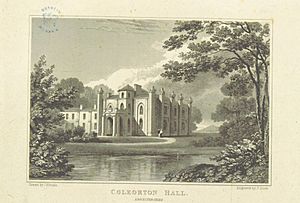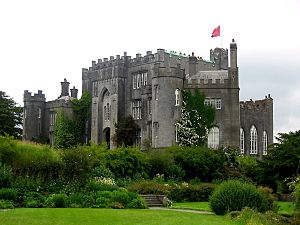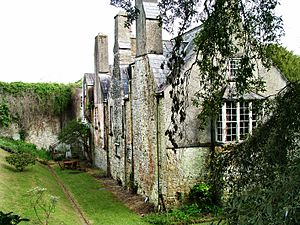Lawrence Parsons (judge) facts for kids
Sir Lawrence Parsons (died 1628) was an English judge and politician in Ireland during the 1600s. He had a very successful career, even though he was sometimes accused of not doing his job well. His success was helped by important people like his uncle, Sir Geoffrey Fenton, and his cousin by marriage, Richard Boyle, the first Earl of Cork. He was also supported by the Duke of Buckingham, a close friend of the King. Sir Lawrence rebuilt Birr Castle, which is still the home of his family today. He is an ancestor of the Earl of Rosse.
Contents
Starting His Career
Lawrence Parsons was born in Leicestershire, England. He was a younger son of James Parsons and Catherine Fenton. Catherine was the sister of Sir Geoffrey Fenton, who was a very important government official in Ireland.
Lawrence moved to Ireland with his uncle, Sir Geoffrey, who worked as the Secretary of State for Ireland from 1581 to 1603. In 1605, Lawrence got his first job as a clerk for the Council of Munster. He also worked with his brother, William, as an escheator and receiver for Munster. They also became joint Surveyors General of the King's lands in Ireland. Both brothers became quite wealthy from their government jobs and by acquiring land.
Lawrence decided to become a lawyer. He joined Gray's Inn in 1606 and became a barrister in 1612. He also joined the King's Inns that same year and became its Treasurer in 1623. In 1612, he was made Attorney General for Munster. He also served in the Irish Parliament from 1613 to 1615 as a Member of Parliament (MP) for Tallow. He was a legal advisor to his cousin, the Earl of Cork. In 1615, he became the Recorder (a type of judge) of Youghal.
Judge of the Admiralty Court
Lawrence Parsons had strong support from his uncle, Sir Geoffrey Fenton, and the Earl of Cork. But his most powerful supporter was George Villiers, the first Duke of Buckingham, who was a close friend of the King. In 1619, Buckingham helped Parsons become the judge of the Irish Court of Admiralty. This court dealt with cases related to the sea and ships.
However, many people thought Parsons was not a good Admiralty judge. He seemed to be lazy and didn't pay much attention to the court's work. The Lord Lieutenant of Ireland, Henry Cary, complained that Parsons didn't do his job and used a deputy instead. In 1626, Parsons faced accusations of mismanaging court funds. The Lord President of Munster, Sir Edward Villiers (Buckingham's half-brother), was understanding. He said Parsons might have taken small amounts but nothing major.
More accusations came in 1627. Parsons and Lord Falkland were accused of making unfair decisions about a Spanish ship called the Vinecorne. This ship, full of wine, was brought to Kinsale as a prize. It was claimed they wrongly decided the ship was not a prize. Parsons was temporarily suspended from his duties while this was investigated. The issue was not resolved before he passed away in 1628.
Baron of the Exchequer Court
In 1624, Lawrence Parsons was appointed as the second Baron of the Court of Exchequer (Ireland). This court handled financial cases. He continued to serve as a judge, traveling to different areas for court sessions.
In his last years, Parsons was trying to keep his position as the Admiralty judge. Adam Loftus, who had held the position before, tried to get it back when Parsons was suspended in 1627. The matter was still undecided when Parsons died in 1628. Loftus then took over the office.
Developing Birr
Lawrence Parsons was very important in developing the town of Birr, County Offaly, which was first known as Parsonstown. In 1620, with help from the Duke of Buckingham, he was given over 1200 acres of land in Offaly and County Longford. This included Birr Castle and the manor of Parsonstown. He also gained the right to hold a local court.
He rebuilt Birr Castle into the form it has today. Parsons was a landlord who worked to improve the area. He built the local church and planned the main street of Birr. He asked for a free school to be set up. He also got permission to hold markets and fairs in Birr. He encouraged a successful glass factory to start in Shinrone, County Offaly. This factory was run by the Bigo family, who were French Huguenots.
Where He Lived
While he is most known for Birr Castle, Lawrence Parsons lived in other places too. For many years, he lived in Myrtle Grove, Youghal. This was once the home of Sir Walter Raleigh. Parsons leased it from the Earl of Cork. He also owned a house in Rathfarnham, Dublin, where he died in September 1628. After his death, his wife lived mostly at Ballydonagh Castle, near Cloughjordan, County Tipperary. This castle was her own property.
His Family
Lawrence Parsons married Anne Malham from Yorkshire. They had three sons and at least two daughters:
- William, whose descendants include the current Earl of Rosse.
- Richard (who died before 1644).
- Fenton.
- Catherine, who married Sir William Cole. Sir William was an MP for County Fermanagh and a Provost of Enniskillen. Catherine was the mother of Michael Cole, an ancestor of the Earl of Enniskillen.
- Anne (died 1634), who married Sir Gerard Lowther. Like her father, Gerard Lowther was a former Attorney General for Munster. He later became a Chief Justice.
Lady Parsons died in October 1646. Her will, made in 1644, still exists. It shows she owned a lot of personal items, including silver basins, and lands. This included her "Castle of Ballydonagh," which she left to William. She also seemed to be a smart businesswoman, as her will mentions several loans she had acquired.




